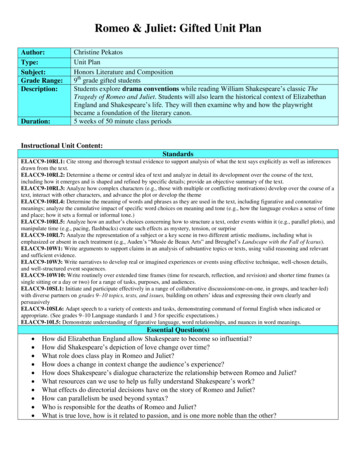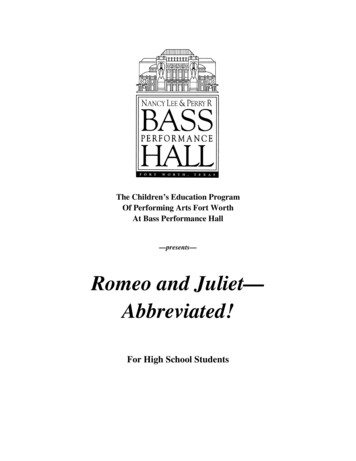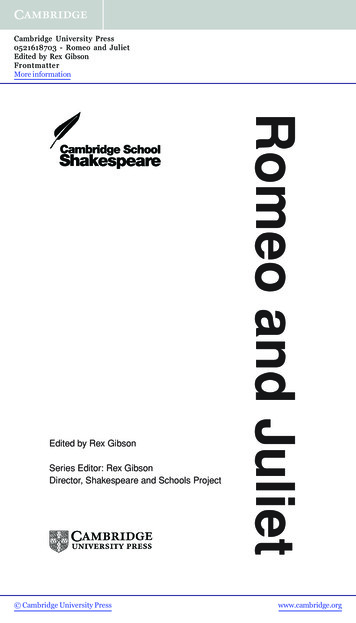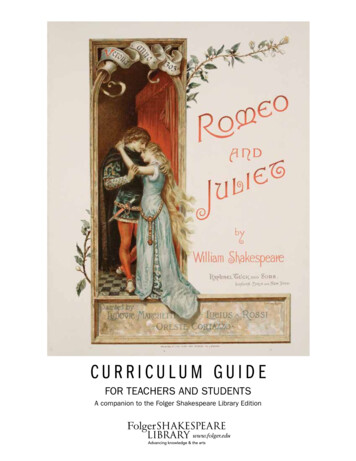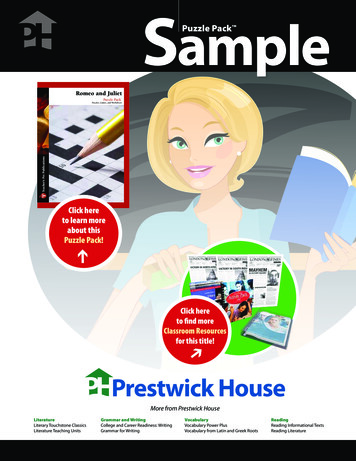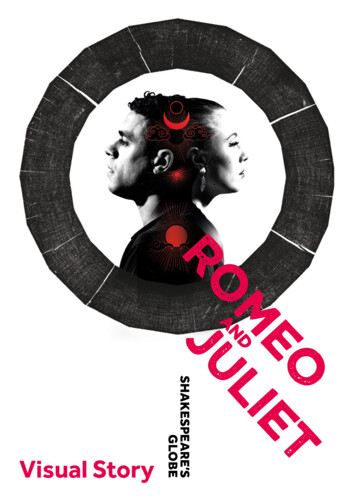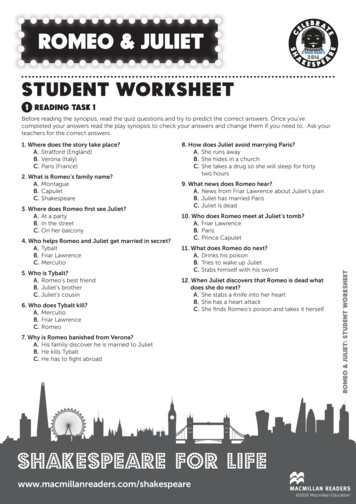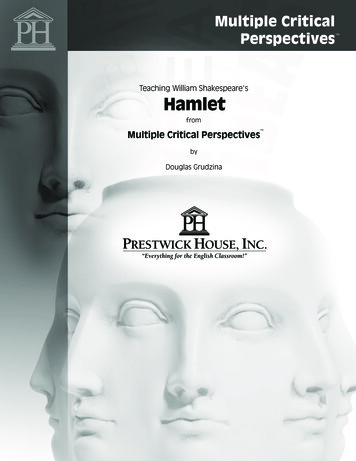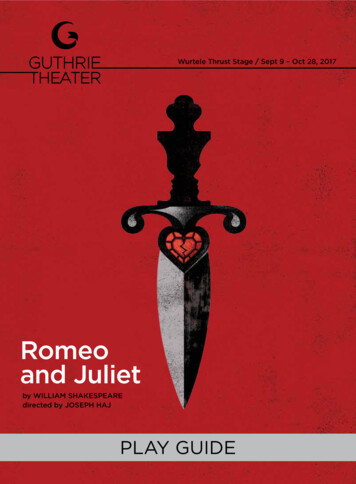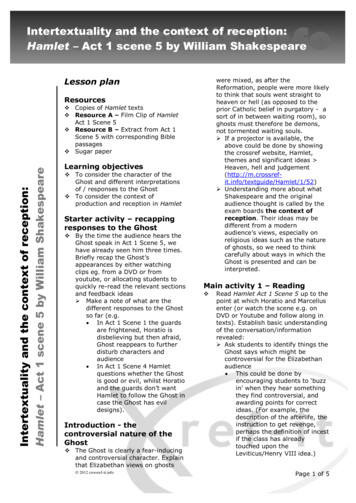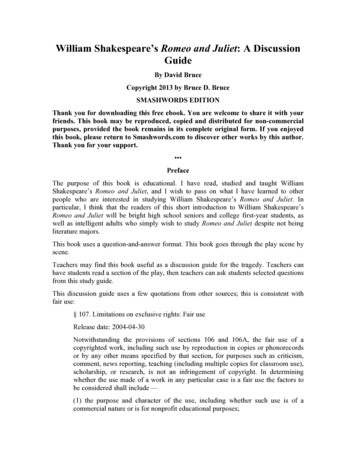
Transcription
William Shakespeare’s Romeo and Juliet: A DiscussionGuideBy David BruceCopyright 2013 by Bruce D. BruceSMASHWORDS EDITIONThank you for downloading this free ebook. You are welcome to share it with yourfriends. This book may be reproduced, copied and distributed for non-commercialpurposes, provided the book remains in its complete original form. If you enjoyedthis book, please return to Smashwords.com to discover other works by this author.Thank you for your support. PrefaceThe purpose of this book is educational. I have read, studied and taught WilliamShakespeare’s Romeo and Juliet, and I wish to pass on what I have learned to otherpeople who are interested in studying William Shakespeare’s Romeo and Juliet. Inparticular, I think that the readers of this short introduction to William Shakespeare’sRomeo and Juliet will be bright high school seniors and college first-year students, aswell as intelligent adults who simply wish to study Romeo and Juliet despite not beingliterature majors.This book uses a question-and-answer format. This book goes through the play scene byscene.Teachers may find this book useful as a discussion guide for the tragedy. Teachers canhave students read a section of the play, then teachers can ask students selected questionsfrom this study guide.This discussion guide uses a few quotations from other sources; this is consistent withfair use:§ 107. Limitations on exclusive rights: Fair useRelease date: 2004-04-30Notwithstanding the provisions of sections 106 and 106A, the fair use of acopyrighted work, including such use by reproduction in copies or phonorecordsor by any other means specified by that section, for purposes such as criticism,comment, news reporting, teaching (including multiple copies for classroom use),scholarship, or research, is not an infringement of copyright. In determiningwhether the use made of a work in any particular case is a fair use the factors tobe considered shall include —(1) the purpose and character of the use, including whether such use is of acommercial nature or is for nonprofit educational purposes;
(2) the nature of the copyrighted work;(3) the amount and substantiality of the portion used in relation to the copyrightedwork as a whole; and(4) the effect of the use upon the potential market for or value of the copyrightedwork.The fact that a work is unpublished shall not itself bar a finding of fair use if suchfinding is made upon consideration of all the above factors.Source of Fair Use information: http://www.law.cornell.edu/uscode/text/17/107 .Very Important Note: The page numbers refer to the Signet Classic edition of Romeo andJuliet. However, the text is that of an online edition of Romeo and Juliet available at http://shakespeare.mit.edu/romeo juliet/full.html . This means that mostly minorvariations in the text will occur. The short quotations (quotations not in block format) arefrom the Signet Classic edition. The long quotations (quotations in block format) arefrom the online edition. Also, I am not using the MLA format, although you may requireyour students to use it.Introduction to Romeo and Juliet Romeo and Juliet was written in 1594, 1595, or 1596, at around the same time as AMidsummer Night’s Dream and Richard II. The time of action is anywhere from the 1200s to the 1500s. The setting is Verona,Italy. At around the time that Shakespeare wrote and his company produced Romeo andJuliet, he bought his father a coat of arms. This means that Shakespeare was a successfulplaywright and was making money. The story of Romeo and Juliet was not invented by Shakespeare, but he did almostwholly invent the character of Mercutio. Shakespeare made Juliet almost 14 years old. In other, earlier versions of Romeo andJuliet by other authors, Juliet had been 18 and 16. Shakespeare also compressed the time it takes for the actions of the play to unfold — 4or 5 days. Romeo and Juliet is a tragedy of chance or accident. Several times, things happen bychance or accident, leading to the tragedy at the end of Romeo and Juliet. For example,Romeo and Juliet meet by chance. An illiterate Capulet servant asks Romeo to read theCapulet invitations to him. Romeo finds out that his beloved, Rosaline (who does notlove him), is invited to the Capulets’ party, and he decides to crash it. There he meetsJuliet and falls in love with her. Romeo and Juliet is also a tragedy of character. If Romeo and Juliet were not so youngand impulsive, they would probably tell their parents that they are married instead of
resorting to outlandish actions to avoid telling them. If Romeo and Juliet had told theirparents that they were married, the play might have had a happy ending. When the two lovers are alone, they are happy. However, the atmosphere of the citythey live in is one of violence. A fight between the Montagues and the Capulets can breakout at any time. One thing that cannot be doubted (or is very difficult to doubt) is that Romeo and Juliet,young as they are, love each other. Romeo and Juliet is a play about passionate love. In this play, we see that the feud between the Montagues and the Capulets has tragicconsequences. Prince Escalus orders the Montagues and the Capulets to stop fighting, butthey continue to fight. If the two families were at peace with each other, the play wouldbe very different. Some sonnets appear in Romeo and Juliet. For example, Romeo and Juliet speak asonnet together as part of their conversation when they first meet. This play has a number of characters who are foils for each other; for example, Tybaltand Benvolio are foils. Here are two definitions of foil:A foil is a character who serves by contrast to highlight or emphasize opposingtraits in another character. For instance, in the film Chasing Amy, the characterSilent Bob is a foil for his partner, [Jay], who is loquacious and foul-mouthed. InShakespeare’s Hamlet, Laertes the man of action is a foil to the reluctant Hamlet.The angry hothead Hotspur in Henry IV, Part I, is the foil to the cool andcalculating Prince Hal.Source: http://guweb2.gonzaga.edu/faculty/wheeler/lit terms F.html.A foil is a character whose personality and attitude is opposite the personality andattitude of another character. Because these characters contrast, each makes thepersonality of the other stand out. In Sophocles’ Antigone, Ismene is a foil forAntigone. Where Antigone is aware of the world, Ismene denies knowledge andhides from it. Where Antigone stands up to authority, Ismene withers before it.Antigone is active and Ismene is passive. Ismene’s presence in the play highlightsthe qualities Antigone will display in her conflict with Creon[,] making her anexcellent foil.Source: tm#F.Romeo and JulietPrologue The Prologue is written in the form of a sonnet. Explain the content of the sonnet.This is the sonnet:PROLOGUETwo households, both alike in dignity,
In fair Verona, where we lay our scene,From ancient grudge break to new mutiny,Where civil blood makes civil hands unclean.From forth the fatal loins of these two foesA pair of star-cross’d lovers take their life;Whole misadventured piteous overthrowsDo with their death bury their parents’ strife.The fearful passage of their death-mark’d love,And the continuance of their parents’ rage,Which, but their children’s end, nought could remove,Is now the two hours’ traffic of our stage;The which if you with patient ears attend,What here shall miss, our toil shall strive to mend.Content of SonnetThe sonnet tells us the subject and ending of the play.The play is about two families in Verona, each of equal rank, who have long quarreled,and whose quarrel breaks out afresh in new violence, disrupting the city.The two families each have a child, whose deaths end the quarrel and the violence. Weare told that only the deaths of these children can end the violence.This, Shakespeare says, will be the subject of this two hours’ long play.What has been left out of the Prologue will be told in the play. If you feel like doing research, explain the characteristics of a Shakespeareansonnet.These are the characteristics of the Shakespearean sonnet: It is a lyric poem of 14 lines. It has three quatrains and a final couplet that makes afitting climax to the sonnet. It is usually written in iambic pentameter. Iambic means a group of two syllables; this group is known as a foot. The first syllableis stressed lightly; the second syllable is stressed heavily. Pentameter means having five feet. Example of Iambic Pentameter:
“The cúrfew tólls the knéll of párting dáy,”From Thomas Gray, “Elegy Written in a Country Churchyard.” It has rhymes that occur in a certain pattern: abab, cdcd, efef, gg. Each section of thesonnet is rhymed differently. It usually expresses a single, complete idea or thought.Chapter 1: Act 1Act 1, Scene 1 The Verona of Romeo and Juliet is a city where violence can break out at any time.What evidence in Act 1, scene 1, supports this statement?We know that the statement is true because we see violence break out in this scene.It is an ordinary day, but Samson and Gregory, who are two servants of Capulet, arelooking for trouble, and they find it.Shakespeare starts with a scene of great action that definitely shows the feud between theCapulets and the Montagues. Like a good storyteller, Shakespeare arouses the audience’sinterest quickly.Act 1, Scene 1 What do Samson and Gregory talk about?The conversation of the two Capulet servants is violent and bawdy.They say what they want to do to the Montague men and to the Montague women.Basically, they want to kill the Montague men, and they want to screw the Montaguewomen. They want to get the Montague women’s backs against a wall and then nail theirasses to the wall. Their language is vulgar.Many of the words they use have a bawdy sense. Those words appear in bold below.GREGORYThat shows thee a weak slave; for the weakest goesto the wall.SAMPSONTrue; and therefore women, being the weaker vessels,are ever thrust to the wall: therefore I will pushMontague’s men from the wall, and thrust his maidsto the wall.GREGORY
The quarrel is between our masters and us their men.SAMPSON’Tis all one, I will show myself a tyrant: when Ihave fought with the men, I will be cruel with themaids, and cut off their heads.GREGORYThe heads of the maids?SAMPSONAy, the heads of the maids, or their maidenheads;take it in what sense thou wilt.GREGORYThey must take it in sense that feel it.SAMPSONMe they shall feel while I am able to stand: and’tis known I am a pretty piece of flesh.GREGORY’Tis well thou art not fish; if thou hadst, thouhadst been poor John. Draw thy tool! here comestwo of the house of the Montagues.SAMPSONMy naked weapon is out: quarrel, I will back thee.These definitions are from The American Heritage Dictionary:Maidenhead:1) The condition or quality of being a maiden; virginity2) The hymenHymen:A tissue that partly or completely occludes [obstructs] the external vaginal orificeAct 1, Scene 1 How does the quarrel between the Montagues and the Capulets start?Some servants of the House of Capulet — Samson and Gregory — start a fight with some
servants of the House of Montague — Abram and Balthasar.This shows us that the violence and hatred between the two families extend even to theservants.Before meeting the Montague servants, the Capulet servants make clear that they hate theMontagues. They wish to kill the Montague men and to rape the Montague women. Theway in which they talk about sexually abusing the Montague women forms a contrast tothe more innocent, though passionate, love that Romeo and Juliet will have for eachother.The Capulet servants are aware of the law against violence in Verona, and they wish topick a fight yet have the other side blamed for the fight. Therefore, Sampson bites histhumb at the Montague servants — this is a grave insult.The servants argue for a while, then Gregory sees Tybalt (one of his master’s kinsmen)coming, and he advises Samson to increase the quarrelsomeness by saying that his masteris better than the Montague servants’ master. Sampson ends up drawing his sword, andthe fight starts.Act 1, Scene 1 Compare and contrast the characters of Tybalt and Benvolio in this scene.Tybalt is violent, while Benvolio is nonviolent.Benvolio’s name reveals his character. “Bene volio” is Latin for “I wish well.”Tybalt is a nephew to Lady Capulet, while Benvolio is a nephew of Montague and afriend of Romeo.Benvolio draws his sword to keep peace between the servants of both houses. Tybaltdraws his sword because he sees Benvolio’s sword out and because he hates allMontagues.On p. 7, we read:Enter TYBALTTYBALTWhat, art thou drawn among these heartless hinds?Turn thee, Benvolio, look upon thy death.BENVOLIOI do but keep the peace: put up thy sword,Or manage it to part these men with me.TYBALTWhat, drawn, and talk of peace! I hate the word,
As I hate hell, all Montagues, and thee:Have at thee, coward!Tybalt is a good fighter, as we will see, and as he says here, he hates all Montagues,including the easy-to-like Benvolio.Two similarities: Both are nephews, and both are loyal to their houses.Act 1, Scene 1 What do we learn about Capulet and Lady Capulet and about Montague and LadyMontague in this scene?We will learn that Lady Capulet is much younger than her husband. Here she mocks hisage. This need not be a bad thing. She may simply be trying to keep him from beingkilled.When Capulet becomes aware of the public violence, he calls for his long sword becausehe wishes to join the violence and fight. However, his wife says that it is moreappropriate for him to call for a crutch than a sword.Lady Montague is also a peacekeeper. Her husband, who is old, wishes to fight, but sheholds him back and will not let him fight.I should point out that the Capulets and the Montagues are not royalty. The word “Lady”is misleading, and Shakespeare did not use it. The Capulet and Montague families arevery wealthy, and they know the Prince, but they are wealthy through trade and business.On p. 7, we read:Enter CAPULET in his gown, and LADY CAPULETCAPULETWhat noise is this? Give me my long sword, ho!LADY CAPULETA crutch, a crutch! why call you for a sword?CAPULETMy sword, I say! Old Montague is come,And flourishes his blade in spite of me.Enter MONTAGUE and LADY MONTAGUEMONTAGUEThou villain Capulet, — Hold me not, let me go.LADY MONTAGUEThou shalt not stir a foot to seek a foe.
Act 1, Scene 1 Write a character analysis of Prince Escalus as he appears in this scene. What doesthe Prince say is the cause of the quarrel between the Capulets and the Montagues?Character AnalysisPrince Escalus is the ruler of Verona, but unfortunately for Prince Escalus, Verona is acity where violence can break out at any time, as we have just seen.Prince Escalus wants his city, Verona, to be peaceful, but that is a difficult task, as wewill see.The Cause of the Quarrel Between the Capulets and the MontaguesApparently, an “airy word” (1.1.92) — someone said something wrong at one time in thepast — is the cause of their quarrel.On p. 8, we read the words of Prince Escalus:Three civil brawls, bred of an airy word,By thee, old Capulet, and Montague,Have thrice disturb’d the quiet of our streets,The Prince is serious about getting peace. He tells the fighters to stop fighting, or theyshall be tortured. He also tells both Capulet and Montague that if violence occurs again,they shall be killed. He then has Capulet go with him and orders Montague to see himlater that day. Apparently, the Prince will talk to each of them about the violence and willtry to uphold the peace.Obviously, the Prince is respected — he is quickly obeyed.On p. 8, the Prince says:Enter PRINCE, with AttendantsPRINCERebellious subjects, enemies to peace,Profaners of this neighbour-stained steel, —Will they not hear? What, ho! you men, you beasts,That quench the fire of your pernicious rageWith purple fountains issuing from your veins,On pain of torture, from those bloody handsThrow your mistemper’d weapons to the ground,And hear the sentence of your moved prince.Three civil brawls, bred of an airy word,
By thee, old Capulet, and Montague,Have thrice disturb’d the quiet of our streets,And made Verona’s ancient citizensCast by their grave beseeming ornaments,To wield old partisans, in hands as old,Canker’d with peace, to part your canker’d hate:If ever you disturb our streets again,Your lives shall pay the forfeit of the peace.For this time, all the rest depart away:You Capulet; shall go along with me:And, Montague, come you this afternoon,To know our further pleasure in this case,To old Free-town, our common judgment-place.Once more, on pain of death, all men depart.Act 1, Scene 1 If you feel like doing research, define “oxymoron” and identify a few of theoxymora that Romeo uses when he finds out that a fight recently occurred.Here is a definition of “oxymoron”:OXYMORON (plural oxymora, also called paradox): Using contradiction in amanner that oddly makes sense. Examples include such oxymora as jumboshrimp, sophisticated rednecks, and military intelligence. The best oxymora seemto reveal a deeper truth through their contradictions. These oxymora are calledparadoxes. For instance, “without laws, we can have no freedom.” Shakespeare’sJulius Caesar also makes use of a famous oxymoron: “Cowards die many timesbefore their deaths” (2.2.32). Richard Rolle uses an almost continuous string ofoxymora in his Middle English work, “Love is Love That Lasts For Aye.”Source: http://guweb2.gonzaga.edu/faculty/wheeler/lit terms O.htmlDate Downloaded: 21 December 2003On p. 11, we read (some oxymora are in bold; emphasis added):ROMEOAlas, that love, whose view is muffled still,Should, without eyes, see pathways to his will!Where shall we dine? O me! What fray was here?
Yet tell me not, for I have heard it all.Here’s much to do with hate, but more with love.Why, then, O brawling love! O loving hate!O any thing, of nothing first create!O heavy lightness! serious vanity!Mis-shapen chaos of well-seeming forms!Feather of lead, bright smoke, cold fire,sick health!Still-waking sleep, that is not what it is!This love feel I, that feel no love in this.Dost thou not laugh?Act 1, Scene 1 What do we learn about Romeo in this scene?1. Romeo and Benvolio are friends. Benvolio is able to talk to Romeo and find out whatis on his mind.2. Romeo dislikes violence. He sees blood on the street and knows that violence hasoccurred there.3. The main thing is that Romeo thinks he is in love with Rosaline, but his love isunrequited. Romeo loves Rosaline, but Rosaline does not love Romeo.4. Romeo does all the things that lovers do when the loved one does not return their love.He sighs, he pines, he wants to be alone, he stands away from his friends, he thinks abouthis loved one and regrets that she does not love him.5. Rosaline wants nothing to do with men. To win heavenly bliss, she intends to remain avirgin on Earth.6. Benvolio wants Romeo to forget about Rosaline and to think about other women.On p. 11, Romeo says about Rosaline that he isOut of her favour, where I am in love.On pp. 12-13, we read:ROMEOBid a sick man in sadness make his will:Ah, word ill urged to one that is so ill!In sadness, cousin, I do love a woman.
BENVOLIOI aim’d so near, when I supposed you loved.ROMEOA right good mark-man! And she’s fair I love.BENVOLIOA right fair mark, fair coz, is soonest hit.ROMEOWell, in that hit you miss: she’ll not be hitWith Cupid’s arrow; she hath Dian’s wit;And, in strong proof of chastity well arm’d,From love’s weak childish bow she lives unharm’d.She will not stay the siege of loving terms,Nor bide the encounter of assailing eyes,Nor ope her lap to saint-seducing gold:O, she is rich in beauty, only poor,That when she dies with beauty dies her store.BENVOLIOThen she hath sworn that she will still live chaste?ROMEOShe hath, and in that sparing makes huge waste,For beauty starved with her severityCuts beauty off from all posterity.She is too fair, too wise, wisely too fair,To merit bliss by making me despair:She hath forsworn to love, and in that vowDo I live dead that live to tell it now.Act 1, Scene 2 In this scene, Paris expresses his desire to marry Juliet. How old is she? Based onevidence in the play, in this society and at this time, is hers a usual age for beingmarried? What were the relative ages of Capulet and Lady Capulet when theymarried?
How old is Juliet?Juliet is not quite fourteen. She is very young indeed.On p. 14, we read:CAPULETBut saying o’er what I have said before:My child is yet a stranger in the world;She hath not seen the change of fourteen years,Let two more summers wither in their pride,Ere we may think her ripe to be a bride.Based on evidence in the play, in this society and at this time, is hers a usual age forbeing married?A fourteen-year-old bride is unusual, but not unheard of. Her father wishes Paris to waittwo more years, then court her. If Juliet is 16, her father does not mind her being married.PARISYounger than she are happy mothers made.CAPULETAnd too soon marr’d are those so early made.What were the ages of Capulet and Lady Capulet when they married?Lady Capulet was much younger than Capulet.Therefore, when Capulet says to Paris, “And too soon marred are those so early made”(1.2.13), he may be speaking from experience. His marriage to Lady Capulet may not beentirely happy — because she was so young when they married.Act 1, Scene 2 Write character analyses of Paris and of Capulet as they appear in this scene.Paris1. Paris seems to be honorable. He wants to marry Juliet, who is very young, but he goesabout it in the right way — by asking her father for her hand.2. Paris is Count (or County) Paris, a member of the upper classes. He is a kinsman toPrince Escalus. A marriage between Juliet and Count Paris would be a good alliance forthe Capulet family.Capulet1. Capulet cares for his daughter, Juliet.
2. He realizes that she is the only child he has left. His other children have died — death(especially in childbirth and of the very young) was common at that time.3. Capulet prefers that Juliet be 16 when she is married, but it’s OK with him if shewishes to marry Paris when she is 14. At this time, Juliet’s preference for Paris will playa role in her marriage, it seems.4. Capulet is concerned about politics. That is what he is talking about at the beginning ofthe scene.On p. 14, we read:Enter CAPULET, PARIS, and ServantCAPULETBut Montague is bound as well as I,In penalty alike; and ’tis not hard, I think,For men so old as we to keep the peace.5. Capulet does have a plan. Instead of his simply telling Juliet to marry Paris, he is goingto invite Paris to a customary feast that his family holds. That way, Paris can court Julietand get her to like him enough to marry him.Act 1, Scene 2 How does Romeo find out about the Capulet feast? What is Romeo’s reaction tothe list of people invited to the Capulet feast? Write a short character analysis of theServant.How Romeo Comes to Know of the Capulet FeastCapulet gives the Servant a list of names of people to invite to the Capulet feast.Unfortunately, the Servant cannot read, and therefore he asks Romeo to read the list ofnames to him.The List of GuestsRomeo’s reaction to the names on the list is “A fair assembly” (1.2.74). Romeo’s reactionis a positive one. He does not hate the Montagues. We can imagine what Tybalt’sreaction to a list of people invited to a Montague feast would be. Tybalt would hate themall. (Tybalt has, by the way, been invited to the Capulet feast.)We also note that Rosaline has been invited to the feast (a fact that Romeo will beinterested in) and that Mercutio has been invited.The Servant1. The Servant is illiterate. In the day and age of the play’s setting, this would be normal.2. Capulet does not know that the Servant cannot read. Is the Servant new? Or doesCapulet not take much interest in household affairs?
3. The Servant does not recognize Romeo and does not know that he is a Montague. TheServant also does not recognize Benvolio, who is with Romeo. This is unusual. Perhapsthe Servant is new.4. The Servant invites Romeo to the Capulet feast, if he be not a Montague. The Servantis aware of the feud between the families. The Servant also takes what I would regard asa liberty. Apparently the Servant is aware that lots of people will be at the feast, so one ortwo more won’t hurt. Probably, lots of party-crashing goes on. Perhaps the Servant isvery young, rather than new.Note: Many people work together to put on plays. Actors can interpret a role in more thanone way without doing violence to the play.Act 1, Scene 2 Why does Benvolio — someone who wishes to avoid violence — want Romeo toattend the feast of the Capulets, sworn enemies to the Montagues? Why does Romeoagree to go to the Capulet feast?I find it interesting that Benvolio wants Romeo and himself to crash the party. (Of course,they have been invited, but only by the servant.) Benvolio wants, of course, for Romeo tosee beautiful women besides Rosaline, but Benvolio should know that trouble could arisebecause of their party-crashing. However, they will be wearing masks, and so apparentlyBenvolio believes that they will not be recognized and so no trouble will occur.Romeo agrees to go to the party because he wants to see Rosaline, whom he loves butwho does not love him back.On p. 17, we read:BENVOLIOAt this same ancient feast of Capulet’sSups the fair Rosaline whom thou so lovest,With all the admired beauties of Verona:Go thither; and, with unattainted eye,Compare her face with some that I shall show,And I will make thee think thy swan a crow.ROMEOWhen the devout religion of mine eyeMaintains such falsehood, then turn tears to fires;And these, who often drown’d could never die,Transparent heretics, be burnt for liars!One fairer than my love! the all-seeing sun
Ne’er saw her match since first the world begun.BENVOLIOTut, you saw her fair, none else being by,Herself poised with herself in either eye:But in that crystal scales let there be weigh’dYour lady’s love against some other maidThat I will show you shining at this feast,And she shall scant show well that now shows best.ROMEOI’ll go along, no such sight to be shown,But to rejoice in splendor of mine own.Act 1, Scene 3 In this scene, the Nurse tells a bawdy anecdote at Juliet’s expense. (“Bawdy”means humorously indecent or vulgar.) What is the anecdote? If Juliet is like mostgirls of her age, would she be embarrassed by the anecdote?The Nurse tells of a time when Juliet was a little girl — a toddler. She fell forward and hither head and raised a large bump. The Nurse says (pp. 19-20):For then she could stand alone; nay, by the rood,She could have run and waddled all about;For even the day before, she broke her brow:And then my husband — God be with his soul!A’ was a merry man — took up the child:‘Yea,’ quoth he, ‘dost thou fall upon thy face?Thou wilt fall backward when thou hast more wit;Wilt thou not, Jule?’ and, by my holidame,The pretty wretch left crying and said ‘Ay.’To see, now, how a jest shall come about!I warrant, an I should live a thousand years,I never should forget it: ‘Wilt thou not, Jule?’ quoth he;And, pretty fool, it stinted and said ‘Ay.’The joke is in the falling. Juliet as a three-year-old fell forward, but when she is older she
will fall backward. She will be lying on her back, her legs in the air, and her legs parted— in the missionary position for sex.Juliet’s ReactionJuliet could have two reactions here — perhaps both at the same time, or one followingthe other.1. Juliet can be embarrassed by the anecdote.2. Juliet can think that the anecdote is funny.Act 1, Scene 3 Write a character analysis of the Nurse based on what you learn in this scene.1. The Nurse can be vulgar. She refers to her maidenhead.These definitions are from The American Heritage Dictionary:Maidenhead:1) The condition or quality of being a maiden; virginity2) The hymenHymen:A tissue that partly or completely occludes [obstructs] the external vaginal orificeOn p. 18, we read:NurseNow, by my maidenhead, at twelve year old,I bade her come. What, lamb! what, ladybird!God forbid! Where’s this girl? What, Juliet!2. The Nurse tells bawdy jokes.A. We have already seen the joke about Juliet falling backwards.B. When Lady Capulet says that Juliet will become no less by having Paris, TheNurse points out that women grow bigger by men — that is, they becomepregnant.On p. 21, we read (Lady Capulet speaks first):So shall you share all that he doth possess,By having him, making yourself no less.NurseNo less! nay, bigger; women grow by men.
C. The Nurse wants Juliet to have happy nights to go with her happy days. The nightswill be happy once Juliet is married because Juliet will be having sex with her husband.On p. 22, we read:NurseGo, girl, seek happy nights to happy days.3. The Nurse is a nursery nurse rather than a doctor’s nurse.4. The Nurse is a wet nurse.We find that out because the Nurse talks of weaning Juliet when Juliet was three yearsold. She weaned Juliet by putting wormwood — a bitter herb — on her nipple so that ittasted bitter and Juliet would not want to nurse any longer.On p. 19, we read:For I had then laid wormwood to my dug,Sitting in the sun under the dove-house wall;My lord and you were then at Mantua: —Nay, I do bear a brain: — but, as I said,When it did taste the wormwood on the nippleOf my dug and felt it bitter, pretty fool,To see it tetchy and fall out with the dug!Shake quoth the dove-house: ’twas no need, I trow,To bid me trudge:5. The Nurse is apparently a widow.We know that she was married because her husband made a bawdy joke at Juliet’sexpense. However, the husband is hereafter no longer referred to in the play.6. The Nurse had a daughter named Susan, who was the same age as Juliet, but whodied, apparently in in
The story of Romeo and Juliet was not invented by Shakespeare, but he did almost wholly invent the character of Mercutio. Shakespeare made Juliet almost 14 years old. In other, earlier versions of Romeo and Juliet by other authors, Juliet had been 18 and 16. Shakespeare also com
